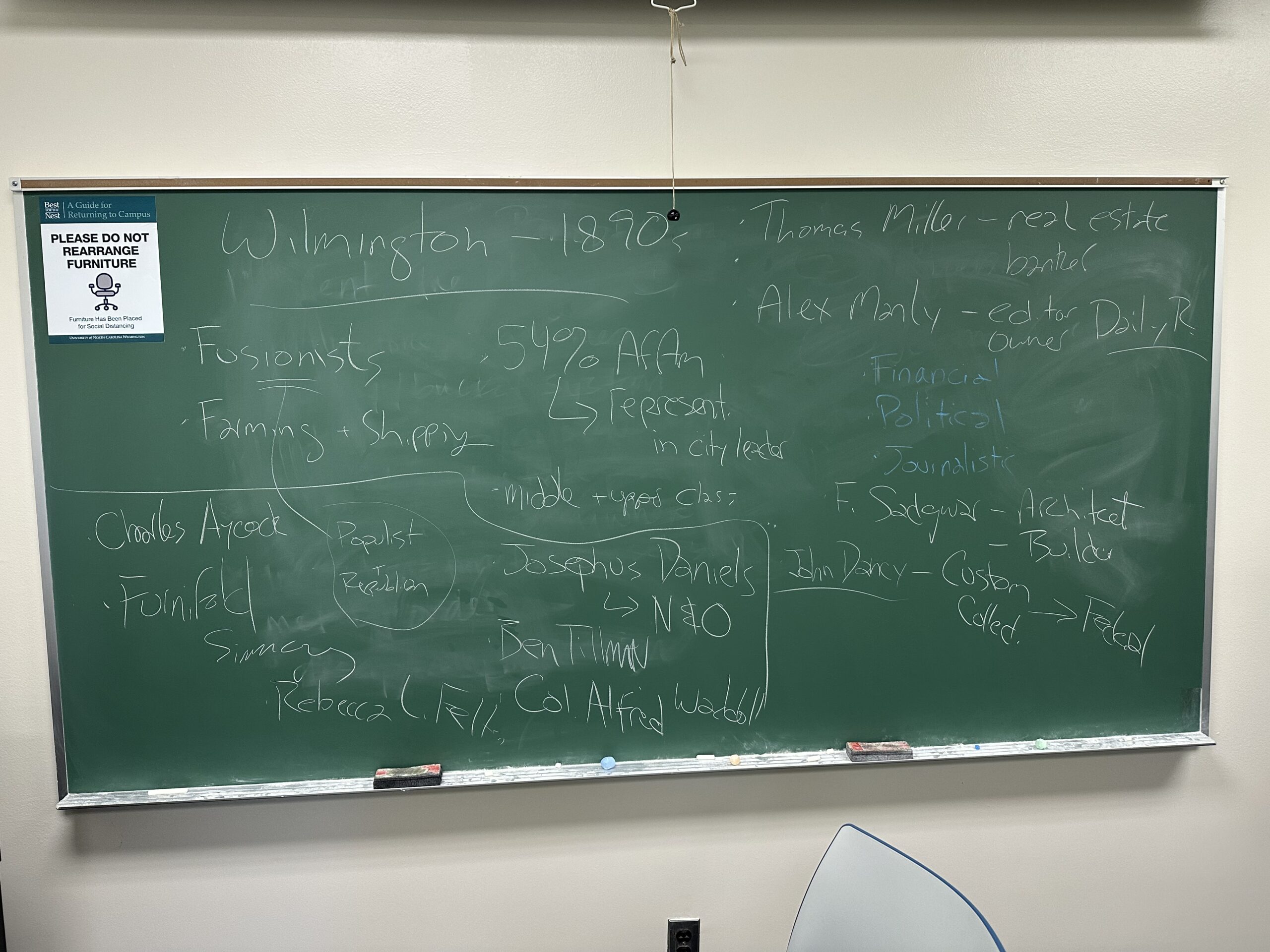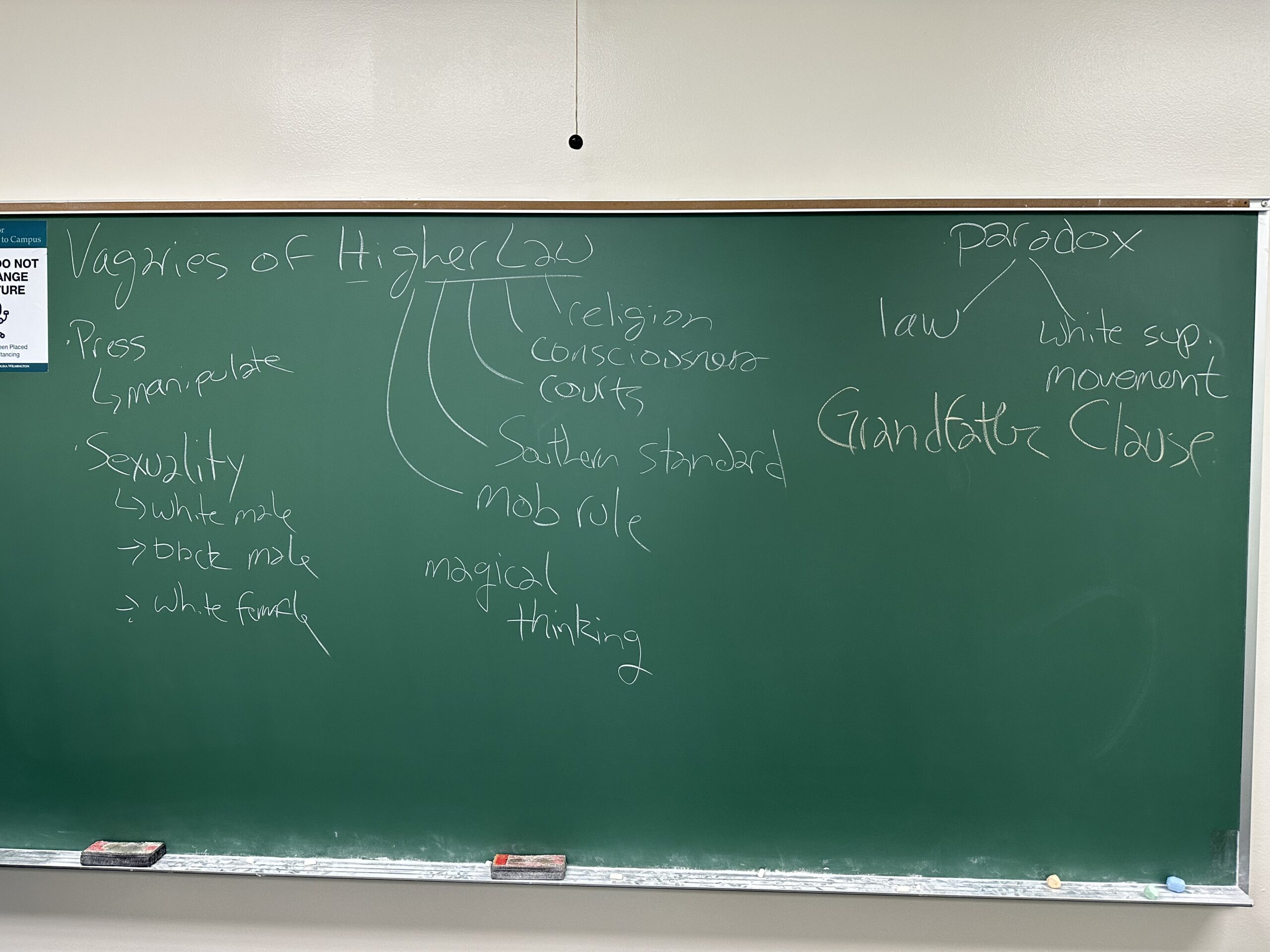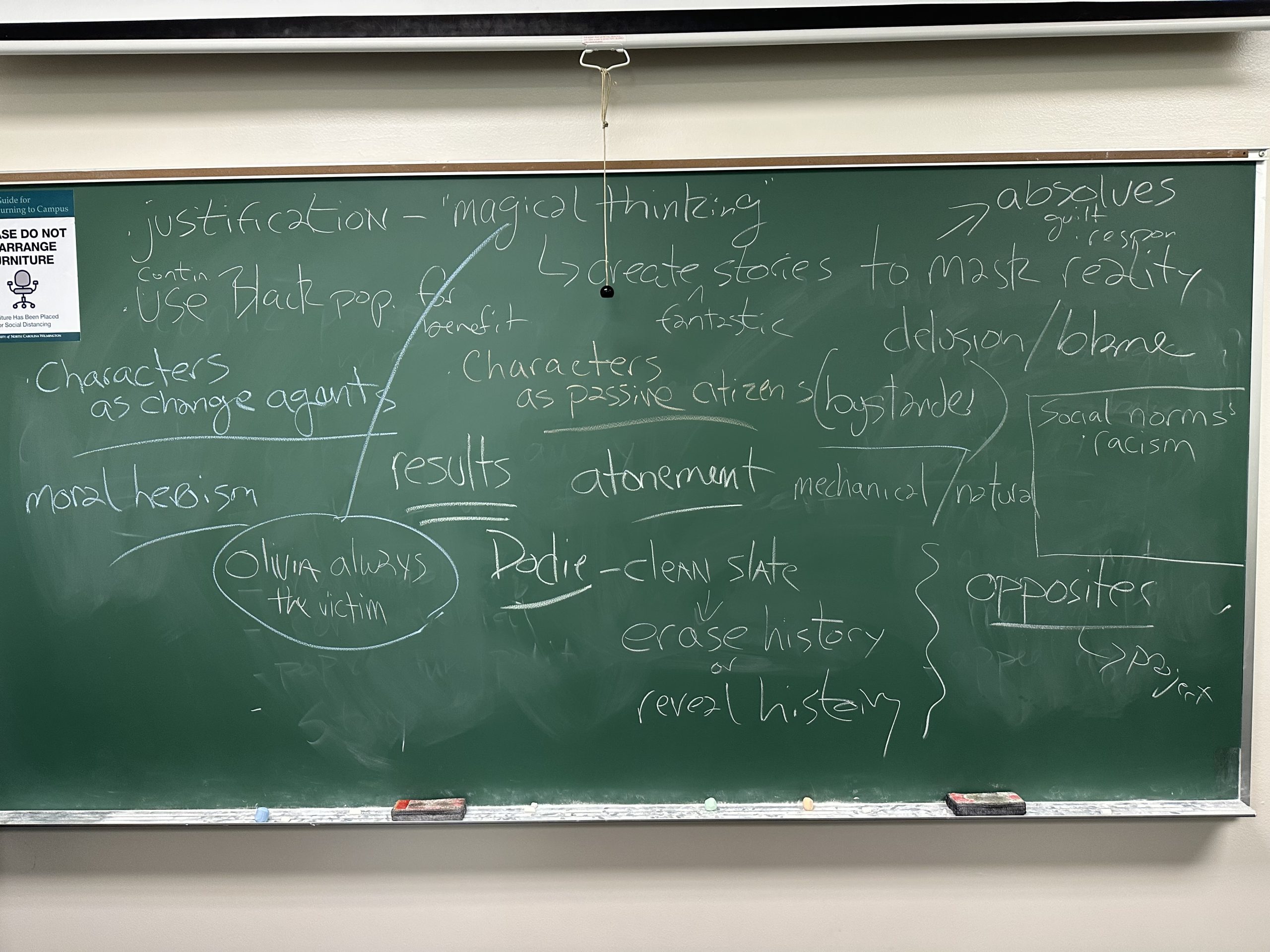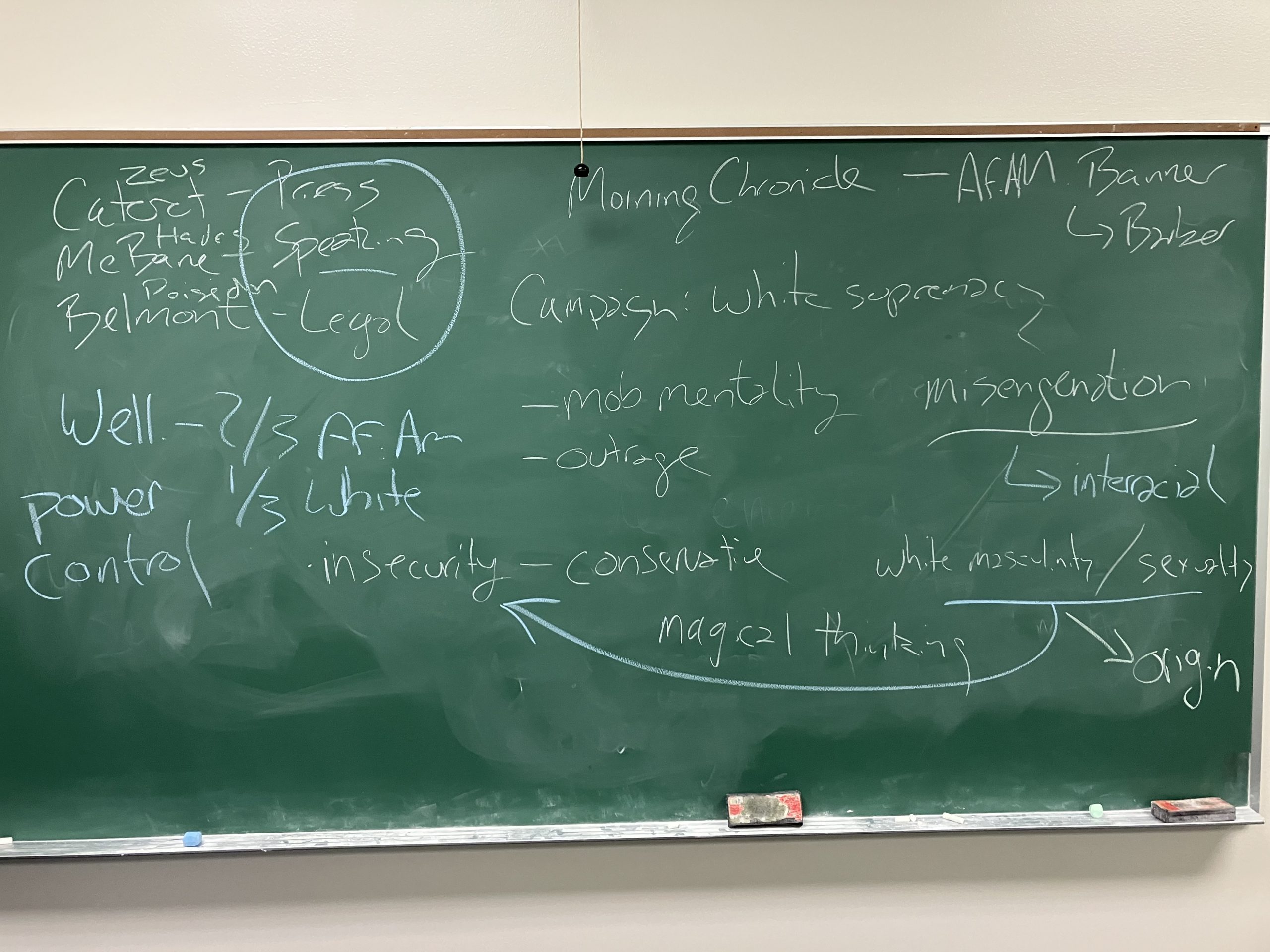Just as we did in the literary analysis unit, the five weeks we are devoting to historical and cultural analysis of the massacre and its aftershocks also uses weekly Discussion Board questions as prompts for our class conversations. They reflect the sequencing of the reading, and ultimately ask students to think about the lasting significance of what happened in their community 125 years ago:

Discussion Board: A Brief History of the Wilmington Massacre
This week we begin the second half of our semester, which will be devoted to the historical and cultural analysis of The Marrow of Tradition. We will be reading nonfiction accounts of the Wilmington Massacre along with various treatises on race and gender and sexuality at the time. We’ll conclude this second section by looking at the long-term legacy and consequences of the massacre and how Chesnutt may or may not have predicted them in his novel.
For this Discussion Post, I’d like you to read H. Leon Prather’s brief, but comprehensive, account of the actual events of 1898 Massacre, “We Have Taken a City.” Then compose a thoughtful Discussion Post that maps this nonfiction account with the similar and dissimilar ways that Chesnutt represents them in his novel. What conclusions can you draw from these similarities and dissimilarities?

Discussion Board: Contextualizing Popular Ideas on Race and Gender
This week you are reading a selection of writings from the turn of the nineteenth century. These pieces address popular—if controversial and insufficient—attitudes about race and gender. For this week’s Discussion Post, I would like you to map the ideas of these different writers onto the ideas expressed by characters in The Marrow of Tradition. For instance, are there similarities between Booker T. Washington’s remarks in his Atlanta Expositionaddress and Dr. Miller? What are they and what do we learn via that similarity? While you do not have to use every single writer, I would like you to include specifics from both the novel and the pieces you quote

Discussion Board: Law and Press
Last week you read specific language from the 13th, 14th, and 15th Amendments to the Constitution, as well as the judicial decision and dissent from Plessy v. Ferguson, which made “separate but equal” the law of the land in the United States. You also read newspaper pioneer Ida B. Wells’s chronicles, and graphic photographs, of lynching throughout the southern U.S. In the first half of this week, you’re reading specific primary documents that directly led to the 1898 Massacre in Wilmington, as well as two letters produced in its aftermath.
Author Charles W. Chesnutt would have read and known all these sources before he began work on The Marrow of Tradition. Now that you’ve read this history, how does it inform your overall understanding of the novel? You don’t have to map individual texts to characters, but rather, using all or most of these sources, reflect on how you now understand the racial and racist climate that produced the Massacre and how Chesnutt represented it in his book.
Discussion Board: Aftermath of 1898 Wilmington Massacre
Charles Chesnutt’s The Marrow of Tradition ends while the Wellington massacre is winding down, leaving readers to wonder what came next for Dr. Miller and his wife Janet, as well as for the Carterets and the rest of the white Wellington elite. The three readings from David Zucchino’s 2021 Pulitzer Prize winning book Wilmington’s Lie: The Murderous Coup of 1898 and the Rise of White Supremacy (pp. 220-357) make clear, in exacting detail, that the damage to the city’s Black community extended long after the killings on November 10, 1898. He also shows how the organizers and executors of the massacre and coup not only were not punished, but thrived in the months, years, and decades after the event.

For your next Discussion Post, I’d like you to both summarize the significant events from Zucchino’s book, and, using that information, hypothesize what would have happened to the remaining characters living in Wellington after the massacre in Chesnutt’s novel.

Discussion Board: 1898 Today
In the epilogue to his book Wilmington’s Lie: The Murderous Coup of 1898 and the Rise of White Supremacy (pp. 329-352), David Zucchino traces the long-term effects of the 1898 Wilmington Massacre on the city and the state of North Carolina, draws some conclusions about the events, and draws some parallels to today’s racial and political climate.
For your final Discussion Post, I’d like you to reflect on whether an event like 1898 could happen in the United States today. Why or why not? What would it look like? How would it be different from the 1898 Massacre, and in what ways would it be similar? Remember, the events of 1898 were not spontaneous, but rather were expertly planned and systematically executed. Are there any parallels?
The key questions that we ask and address during the second unit include:

- How does the novel represent the realities of the massacre?
- How was the massacre and coup a systemic process rather than a spontaneous act?
- How did the judicial system in America aid in the massacre and coup?
- How did churches preach “the Gospel of White Supremacy”?
- What role did newspapers play in the run-up and aftermath of the massacre?
- What, if anything, could the Black community do to prevent the massacre? And why do we ask that question of the Black community and not the White community?
- How do the philosophies of DuBois and Washington map onto the leadership approaches of Black leaders in Wilmington?
- What are the social conditions that help foment a racial massacre and governmental coup?
- What do you think Wellington looked like after it’s fictional massacre? How does the past 125 years of Wilmington’s history inform you ideas?
- How has the city of Wilmington and state of North Carolina addressed and reconciled the events of the Wilmington massacre and coup?
- How should we understand the 1898 Wilmington Memorial and various historical plaques throughout the city? Where are plaques and recognition missing?